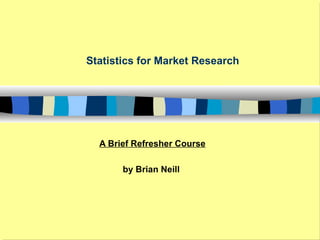
Statistics Review
- 1. Statistics for Market Research A Brief Refresher Course by Brian Neill
- 6. Sampling used to measure Parent Population ******* >>>^^^^^^^ ********^^^^ ^^*******>>>> ********^^^^^^ ^^^^^^^^^^^ ^^^>>>>>>> ******^^ * Parent Population : Group under study >***>^^^^**^ Sample is taken from parent population. Measurements are taken on the sample. If sampling was done correctly. measurements are representative of the Parent Population
- 15. Confidence Intervals 1.96 std deviations S ( ) = 95% of all observations
- 17. Confidence Intervals 1.96 std deviations S ( ) = 95% of all observations 14,000 20,000 Est. Mean = 17,000 95% chance the true mean falls within here
- 19. Confidence Intervals 1 S ( ) std deviations = 68.2% of all observations 15,500 18,500 17,000 68% chance the true mean falls within here
- 31. Proof that CAGR is right We can check our answer by adding 11.4186% growth every year and you’ll arrive at the correct final year revenue 3.04B, exactly right!
- 32. Plotting These Average Growth Rates 17%
Notes de l'éditeur
- Parameter- a measurement of of the Parent Population.(e.g. average income of all the Volvo in the world)
- NONProbabuility Samples:Convenience Samples Jugement Samples --sample elements are hand-picked which is what we doQuota Samples-
- Often we don’t know how the “real world” population is distributed, so we have to estimate ().There is no problem for two reasons: 1. variation usually changes for most variables of interest in marketing So, if the study is a repeat we can use old values we found for .2. We can calculate smaple variance Need to add blurb on “standard error of estimate”
- Often we don’t know how the “real world” population is distributed, so we have to estimate ().There is no problem for two reasons: 1. variation usually changes for most variables of interest in marketing So, if the study is a repeat we can use old values we found for .2. We can calculate smaple variance Need to add blurb on “standard error of estimate”
- Often we don’t know how the “real world” population is distributed, so we have to estimate ().There is no problem for two reasons: 1. variation usually changes for most variables of interest in marketing So, if the study is a repeat we can use old values we found for .2. We can calculate smaple variance Need to add blurb on “standard error of estimate”
- Often we don’t know how the “real world” population is distributed, so we have to estimate ().There is no problem for two reasons: 1. variation usually changes for most variables of interest in marketing So, if the study is a repeat we can use old values we found for .2. We can calculate smaple variance Need to add blurb on “standard error of estimate”
- Often we don’t know how the “real world” population is distributed, so we have to estimate ().There is no problem for two reasons: 1. variation usually changes for most variables of interest in marketing So, if the study is a repeat we can use old values we found for .2. We can calculate smaple variance Need to add blurb on “standard error of estimate”
- Often we don’t know how the “real world” population is distributed, so we have to estimate ().There is no problem for two reasons: 1. variation usually changes for most variables of interest in marketing So, if the study is a repeat we can use old values we found for .2. We can calculate smaple variance Need to add blurb on “standard error of estimate”
- Revenues above are from Wholesale Carrier B&C Forecast.From Frost & sullivan report 2006